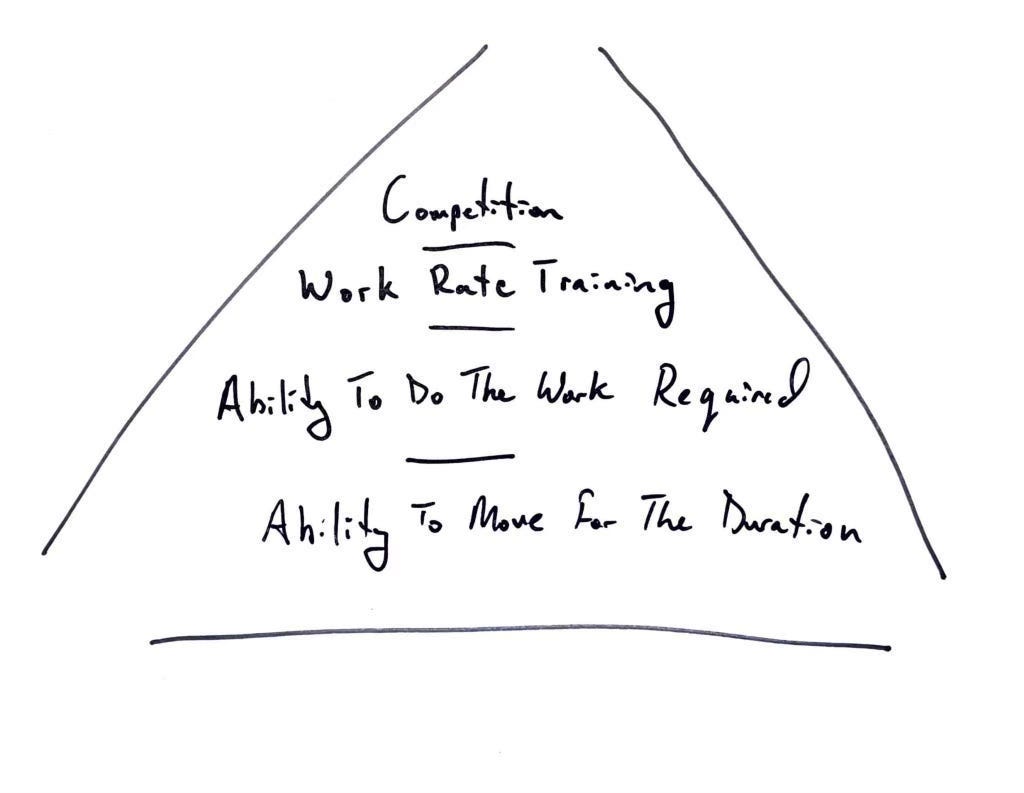Chapter One discussed the progression of an athlete using four frameworks:
The chapter also explained the performance pyramid (below).
Use these as a checklist to guide your approach up the competitive ladder.
From Chapter Ten, our journey up the competitive ladder requires gradually increasing commitment.
The progression from Novice to Top Amateur:
Something most mornings.
Something every morning.
Something every morning, and going long on the weekends.
Something every morning, going long on the weekends, and double sessions some weekdays.
Gain Control of Our Mornings.
These stages match the following competitive levels:
Improve Health.
Novice Athlete.
Developing Athlete.
Competitive Athlete.
Top Amateur.
Through the application of work over time, we approach our ultimate potential. Our ultimate potential being a function of the work we put in, and our individual response to that work.
It’s natural to focus on the work but, long term, it becomes increasingly important to focus on improving our response.
Stress - Response
When we are new, any reasonable training approach will work. When we are young, we have the capacity to absorb a lot of training mistakes. Our first few seasons, it doesn’t really matter what we do => so long as we do something, most days.
However, as we near the top of our racing category and as the fatigue (and fitness) builds… we will need to be smarter.
As an elite, a strategy of being smarter didn’t cross my mind. Our game was load maximization.
The link below will take you to a case study of a load maximization approach. It’s a trip report written by an amateur friend who trained alongside a couple of elites.
Hard Things Break
Unsustainable load is, not surprisingly, unsustainable. Over long time horizons (your athletic career, for example), extreme load doesn’t create sustainable competitive advantage.
Why?
First, because we are constrained.
Constrained in the amount of work we can fit into our schedule.
Constrained by the amount of work we will enjoy.
Constrained by the amount of work that will generate a positive response.
The approach we outline in our book, specifically in Chapter Ten, focuses on sustainable excellence.
These strategies are available to athletes at all levels, forever. They don’t rely on talent, experience or the ability to tolerate extreme loads. As you head towards the sharp end of your category, load becomes less meaningful. At the sharp end, everyone does the work.

I want to highlight Manuel’s point…
People who train seriously year-round will not see a clear relationship between CTL and their performance.1

Sustainable Advantage
As amateurs, and elites who will one day be amateurs, how can we differentiate ourselves?
We build a habit of being smarter than our compulsive selves.

Sustainable advantage begins with the end in mind.
The progression from Novice to Top Amateur:
Something most mornings.
Something every morning.
Something every morning, and going long on the weekends.
Something every morning, going long on the weekends, and double sessions some weekdays.
Gain Control of Our Mornings.
Control of Schedule. Gain control of the time required to train like a Top Amateur. Control of time, gives us a sustainable advantage in all areas of our lives.
Radical Recovery. From 2022 to 2025, half my days were easy. This was unheard of when I was an elite. We weren’t merely load maximizers, we were stress maximizers, too.
Don’t Be A Nut. The higher our competitive level, the more compulsive the competition. Reduce the number of times we beat ourselves.
Everything Counts. The higher our athletic level, and the busier our baseline schedule, the greater the value of what we don’t notice. What don’t we notice? Often, it’s the value of our easy days, our Zone 1 training and staying on top of our overall life commitments. When fatigue rises, you experience setbacks or your schedule gets tight… you’ll be tempted to discard what you don’t see. The low stress parts of your program are essential.
These four points:
Control of Schedule
Preemptive Recovery
Not Beating Ourselves
Prioritizing Low Stress Periods
…will enable better long term adaptations at every competitive level.
Back to Table of Contents
Please see How I Track TSS for useful background and additional points about the limits of tracking load.






